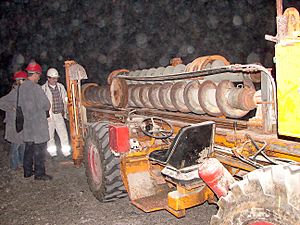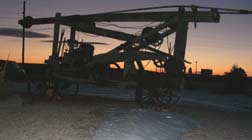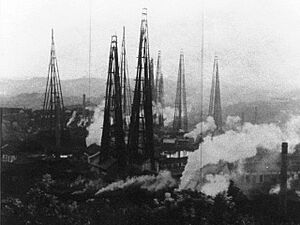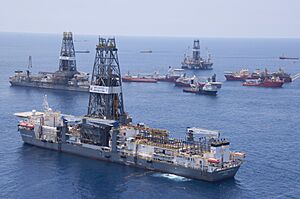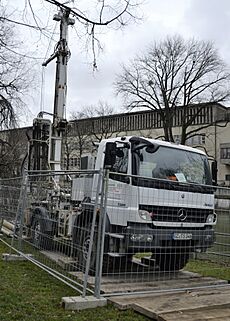Drilling rig facts for kids

A drilling rig is a special machine. It drills holes deep into the Earth. These holes can be for finding water, oil, or natural gas. They can also be used for building things like strong foundations.
Some drilling rigs are very big. They are like giant towers with lots of equipment. These huge rigs drill deep wells for oil or gas. Other rigs are small enough for one person to use. These smaller ones are often called augers.
Drilling rigs can do many jobs. They can find minerals underground. They test rocks, soil, and water deep in the ground. Rigs can also help install pipes or build tunnels underground. Some rigs can move around on trucks or tracks. Others are fixed in one place, like big structures on land or in the ocean. The word "rig" usually means the complex equipment that digs into the Earth's surface.
Small and medium-sized drilling rigs can move easily. They are used for finding minerals or drilling water wells. Bigger rigs can drill thousands of meters deep. They use large pumps to move a special liquid called "drilling fluid." This fluid cools the drill bit and carries rock pieces to the surface. Strong cranes on the rig can lift hundreds of tons of drill pipe. Some rigs can even push acid or sand into the ground. This helps get more oil or gas out. In faraway places, rigs might have homes and food for the workers. Some rigs in the ocean work very far from land.
Contents
How Drilling Rigs Started
For a long time, people used their own strength to drill. This was before modern engines were invented. The idea of drilling for oil goes way back. The ancient Chinese used a method called percussion drilling. This was around 100 BC in the Sichuan province. They used it to get natural gas.
Early drilling was simple but clever. Workers used heavy iron bits and long bamboo poles. They made strong ropes from bamboo fibers. Two to six men would jump on a lever. This made the heavy bit drop into a hole. These early wells were about 10 meters deep. By the 10th century, they could reach 100 meters. By the 16th century, Chinese wells were over 2,000 feet deep! This Chinese drilling method came to Europe in 1828.
In 1859, an American named Edwin Drake used a similar idea. He drilled Pennsylvania's first oil well. But he used small steam engines instead of people. This made drilling much faster. The first main product from these wells was kerosene for lamps.
In the 1970s, new drilling methods appeared. For most shallow drilling, older roller bits were replaced. New drills used air pressure to break rocks. These were much faster and worked better. Diamond drilling, however, has stayed mostly the same since it started.
Drilling for Oil and Gas
Oil and natural gas drilling rigs do two main things. First, they find where oil or gas is hidden underground. Second, they make holes to bring that oil or gas to the surface.
Once a well is drilled, the drilling rig moves away. Then, a smaller machine called a "service rig" takes over. This service rig helps get the well ready to produce oil or gas. This way, the main drilling rig can go drill another hole. This makes the work faster and more specialized.
Drilling for Mining
Mining drilling rigs have two main uses. One is "exploration drilling." This helps find where minerals are and how good they are. The other is "production drilling." This is part of the actual mining process.
Rigs used for blasting rocks in surface mines come in different sizes. This depends on how big the hole needs to be. Underground mines use various rigs too. They drill for different purposes, like getting minerals, adding support, or making tunnels.
Mobile Drilling Rigs
In the past, drilling rigs were often built on site. They stayed there even after the well was finished. Today, drilling rigs are very expensive. They are custom-built machines. They can be moved from one well to another.
Some smaller rigs are like mobile cranes. They are often used to drill water wells. Larger rigs on land must be taken apart. Then they are moved in sections to a new location. This process can sometimes take weeks.
Small mobile rigs also drill holes for foundations. These rigs use similar technology to oil rigs, but on a smaller scale.
Automated Drill Rigs
An automated drill rig (ADR) is a modern, smart drilling machine. It can move itself around. It drills long, horizontal sections for oil and gas wells. ADRs can move from one drilling spot to another faster than other big rigs. Each of these rigs can cost around $25 million.
ADRs are used a lot in places like the Athabasca oil sands. Companies say ADRs are safer to use. They have better controls and cause less harm to the environment. They can also move quickly. In 2005, the first ADR designed for a special oil recovery method was used.
Auger Drills
An auger drill is a tool shaped like a spiral screw. Its main job is to drill holes in the ground. It can also drill into ice or wood. The design of an auger changes depending on what it will drill. There are many types of auger drills.
Auger drills come in different sizes. They can drill holes up to 95 feet deep. They are very useful and save time and effort. An auger is a steel screw with curved blades. It spins as it is pushed into the ground. As it spins, it brings the dirt to the surface. This keeps the hole open.
Augers can be attached to trucks or other machines. They come in different lengths and widths. Auger drilling is used in many areas. These include construction, environmental studies, and checking soil. It can also be used for:
- Putting in strong foundations for buildings.
- Drilling holes for telephone poles or fence posts.
- Small home projects like gardening or planting.
- Ice fishing.
There are different ways to use augers. Hand auger drilling is cheaper. It is used for shallow soil. But it can take a lot of time and effort. Hollow stem auger drilling uses a large, hollow auger. It removes soil as it drills.
Auger drilling is often quieter than other methods. It also causes less shaking. This means it can be used in cities. When using an auger, always be safe. Wear protective gear like gloves and eye protection. Make sure the auger is secure. Start drilling slowly.
Drill Buckets
A drill bucket, or auger bucket, is a special drilling head. It collects the dirt inside it. The bucket can then be lifted out of the hole to be emptied.
See also
- Boring
- Casing cutter
- Laser drilling
- Parts of oil drilling rigs
- Enhanced geothermal system
- Flame jet drill
- Mineral exploration
- Oil platform
- Oil well
- Pumpjack
- Subsea technology
- Big Stan (drill rig)
- Horizontal directional drilling


